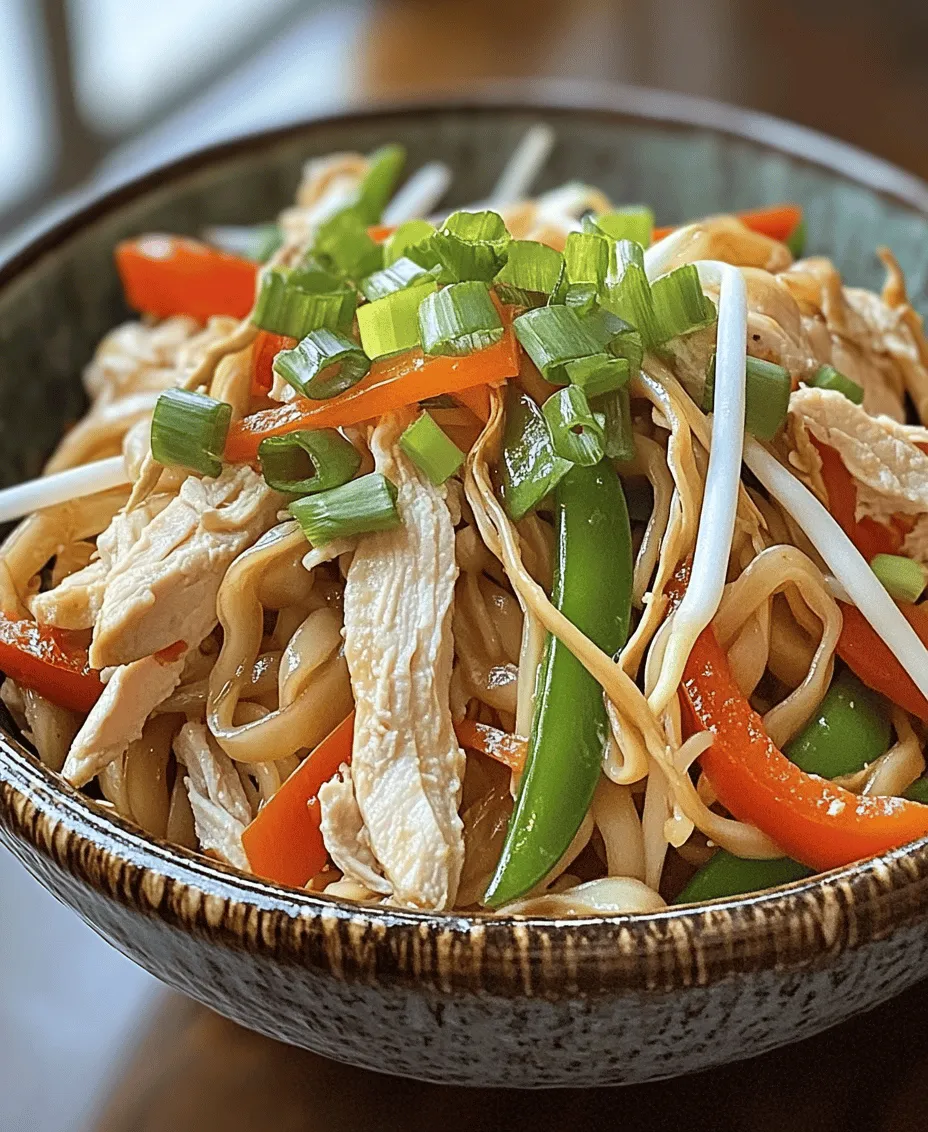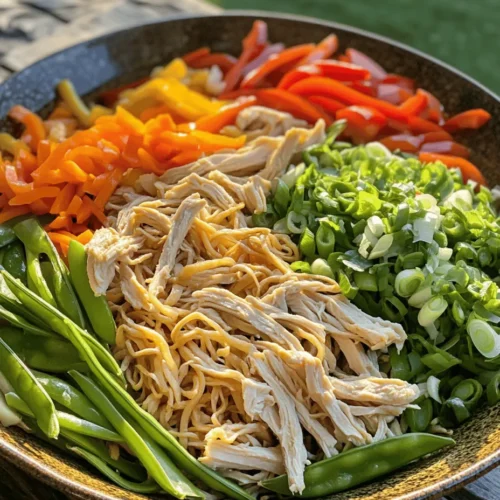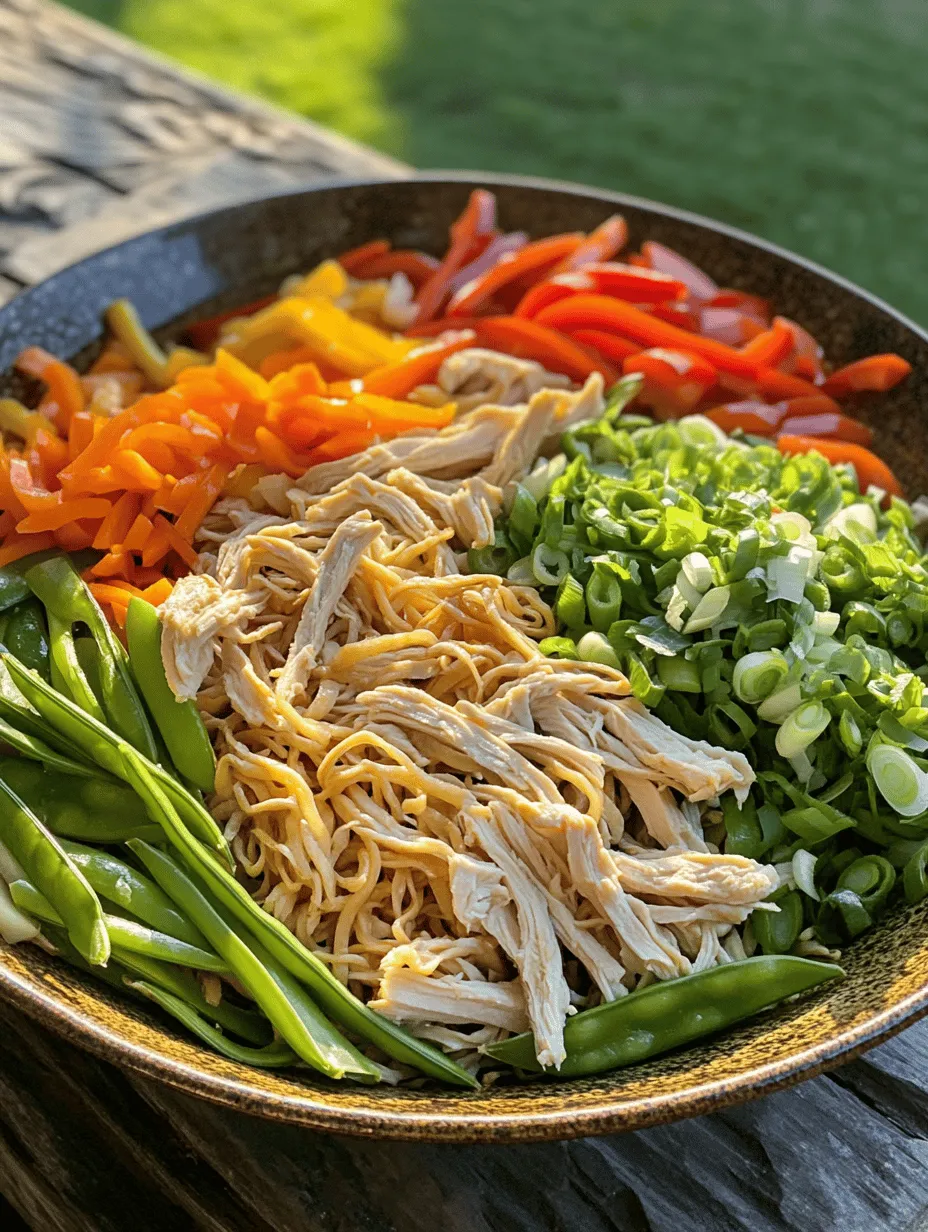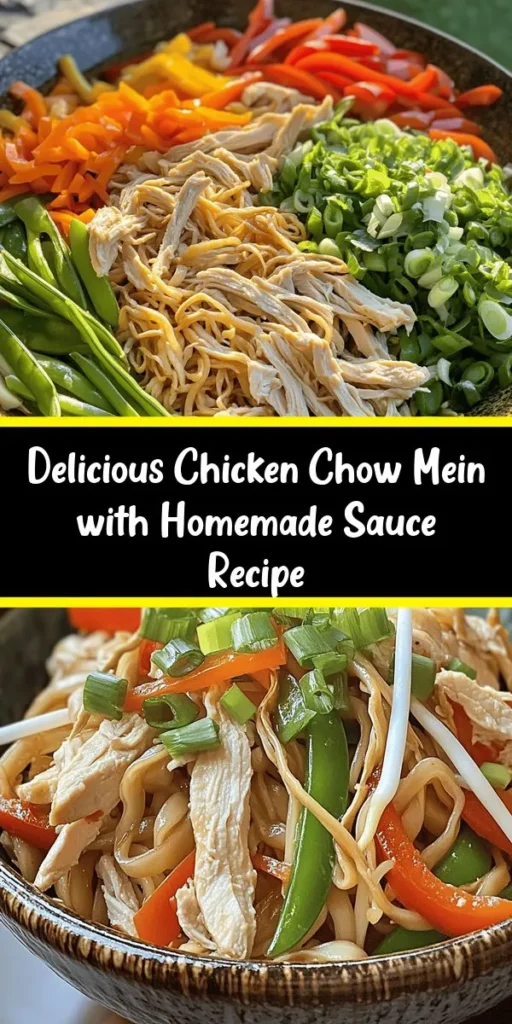Introduction
If you’re a fan of Asian cuisine or simply love a hearty, flavorful meal, then Chicken Chow Mein is a dish that deserves a prominent place in your recipe repertoire. This delightful stir-fried noodle dish combines tender chicken, crisp vegetables, and a savory chow mein sauce, creating a symphony of flavors that tantalizes the taste buds. Not only does this recipe simplify the cooking process, making it accessible for home cooks of all skill levels, but it also emphasizes the importance of fresh ingredients and a balanced flavor profile.
Chow Mein has become a beloved staple in many households, often featured on menus at Chinese restaurants around the world. However, the joy of preparing this dish at home allows you to customize it to your preferences while enjoying the satisfaction of creating restaurant-quality meals in your own kitchen. In this guide, we will walk you through the ins and outs of making Chicken Chow Mein, focusing on the essential ingredients, the all-important chow mein sauce, and the preparation steps that will set you up for success.
Understanding Chow Mein
Exploring the Origins of Chow Mein
Chow Mein, which translates to “stir-fried noodles,” has a rich history rooted in Chinese culinary traditions. Its origins can be traced back to the Taishan region of Guangdong province in southern China, where it was brought to the United States by Chinese immigrants in the late 19th century. Over the years, Chow Mein has evolved into various forms, adapting to local tastes and ingredient availability, resulting in a diverse array of versions across different cultures and regions.
In the United States, for example, Chow Mein typically features crispy fried noodles topped with sautéed vegetables and meat, often served with a rich sauce. In contrast, Cantonese-style Chow Mein showcases softer, more delicate noodles that are stir-fried alongside an assortment of vegetables and proteins. Other variations can be found in different countries, such as Singapore Chow Mein, which incorporates curry flavors, or Americanized versions that may include a medley of additional ingredients like egg and bean sprouts.
The Essence of Chow Mein Sauce
At the heart of any great Chow Mein dish lies the sauce, which serves as the flavor backbone and elevates the dish from ordinary to extraordinary. The chow mein sauce is usually a harmonious blend of soy sauce, oyster sauce, sesame oil, and other seasonings that provide umami, sweetness, and depth. The key to creating a delicious chow mein sauce is to strike a balance between these flavors, ensuring that each component enhances the overall dish without overpowering it.
The ingredients in the chow mein sauce each contribute unique attributes:
– Soy Sauce: This staple ingredient adds saltiness and depth, serving as the base flavor for the sauce.
– Oyster Sauce: With its rich, slightly sweet flavor, oyster sauce brings complexity and a hint of sweetness to the mix.
– Sesame Oil: A few drops of this aromatic oil lend a nutty flavor that is quintessential in Asian cooking.
– Cornstarch: Often used as a thickening agent, cornstarch contributes to the sauce’s consistency, ensuring it clings beautifully to the noodles and other ingredients.
By preparing your own chow mein sauce, you not only control the quality of the ingredients but also customize the flavors to suit your taste. In this recipe, we will guide you through the process of making a homemade chow mein sauce that will leave your taste buds dancing with delight.
Ingredients Overview
Essential Ingredients for Chicken Chow Mein
To create a delicious Chicken Chow Mein, gathering the right ingredients is crucial. This dish primarily revolves around three components: chicken, noodles, and vegetables. The following is a breakdown of the essential ingredients you will need:
– Chicken: Boneless, skinless chicken breast or thighs are ideal for this recipe. They are quick to cook and absorb flavors well, providing a tender and juicy protein base.
– Noodles: Chow Mein noodles are typically thin egg noodles, which are slightly chewy and perfect for stir-frying. However, you can also use other types of noodles, such as rice noodles or even whole wheat noodles, depending on your preference.
– Vegetables: A colorful mix of vegetables not only enhances the visual appeal of the dish but also adds nutrition and texture. Common choices include bell peppers, carrots, broccoli, snap peas, and bean sprouts. Fresh produce is essential to achieve a crisp and vibrant dish.
– Chow Mein Sauce: As discussed previously, the sauce is a vital component of this recipe, enhancing the flavors of the chicken and vegetables.
Using high-quality, fresh ingredients is key to achieving the best results. The combination of tender chicken, perfectly cooked noodles, and crisp vegetables, all coated in the savory chow mein sauce, makes for a balanced and satisfying meal.
A Closer Look at the Chow Mein Sauce
The chow mein sauce is where the magic truly happens. Here’s a detailed analysis of each component of the sauce, including their role in enhancing the overall flavor of the dish:
– Soy Sauce: A fundamental ingredient in Asian cooking, soy sauce introduces saltiness and richness. Opt for low-sodium soy sauce if you prefer a lighter flavor.
– Oyster Sauce: This sauce is a blend of oyster extracts and seasonings, providing a sweet and savory taste. Look for a high-quality oyster sauce to maximize flavor.
– Sesame Oil: A small amount of sesame oil goes a long way in adding an aromatic, nutty element to the sauce. Use toasted sesame oil for an even more intense flavor.
– Cornstarch: Cornstarch is essential for thickening the sauce, helping it to adhere to the noodles and ingredients. Mix it with a bit of water to create a slurry before adding it to the sauce.
– Garlic and Ginger: Freshly minced garlic and ginger add aromatic depth and a zesty kick, enhancing the overall flavor profile of the chow mein sauce.
By making your chow mein sauce from scratch, you can experiment with different ratios of these ingredients to create a sauce that perfectly suits your taste preferences. The beauty of homemade sauce is that it can be tailored to your liking, whether you prefer a sweeter, spicier, or more savory flavor.
Preparation Steps
Preparing the Chow Mein Sauce
Creating the chow mein sauce is a straightforward process that can be accomplished in just a few steps. Here’s how to whisk together this essential component:
1. Gather Ingredients: You will need soy sauce, oyster sauce, sesame oil, cornstarch, minced garlic, minced ginger, and a splash of water.
2. Mix the Base: In a medium bowl, combine approximately 1/4 cup of soy sauce with 2 tablespoons of oyster sauce. Add 1 teaspoon of sesame oil for that distinctive nutty flavor.
3. Add Aromatics: Stir in 2 cloves of minced garlic and 1 teaspoon of minced ginger to infuse the sauce with aromatic depth.
4. Thicken the Sauce: In a separate small bowl, mix 1 tablespoon of cornstarch with 2 tablespoons of water to create a slurry. This will help thicken the sauce.
5. Combine: Pour the cornstarch mixture into the sauce mixture while whisking continuously to prevent lumps from forming. Your chow mein sauce is now ready to use!
Cooking the Chow Mein Noodles
Cooking the noodles properly is crucial to achieving the perfect texture in your Chicken Chow Mein. Follow these steps to ensure your noodles are cooked to perfection:
1. Boil Water: In a large pot, bring a pot of salted water to a rolling boil.
2. Cook the Noodles: Add the chow mein noodles to the boiling water and cook according to the package instructions, usually around 3-5 minutes. Stir occasionally to prevent sticking.
3. Rinse and Drain: Once the noodles are cooked, drain them in a colander and rinse them under cold water. This step is essential as it stops the cooking process and helps to remove excess starch, preventing the noodles from becoming gummy.
4. Set Aside: Toss the rinsed noodles with a small amount of sesame oil to prevent them from sticking together and set them aside while you prepare the rest of the dish.
Sautéing the Chicken
The chicken is the star of your Chicken Chow Mein, so it’s important to cook it properly to ensure it is tender and flavorful. Here’s how to sauté the chicken effectively:
1. Prepare the Chicken: Slice the boneless, skinless chicken breasts or thighs into thin strips to allow for even cooking. Season the chicken with a pinch of salt and pepper.
2. Heat the Pan: In a large wok or skillet, heat a tablespoon of vegetable oil over medium-high heat until it shimmers.
3. Cook the Chicken: Add the chicken strips to the hot pan in a single layer. Allow them to cook undisturbed for about 2-3 minutes until they are golden brown on one side.
4. Stir-Fry: Once the chicken is browned, stir-fry for another minute or two until fully cooked through. The internal temperature should reach 165°F (75°C). Remove the chicken from the pan and set it aside.
By following these steps, you’ll ensure that your Chicken Chow Mein is not only delicious but also a true representation of this beloved Asian dish. In the next part of this article, we will continue with the remaining preparation steps for assembling and cooking your delightful Chicken Chow Mein, ensuring that every bite is full of flavor and satisfaction.

The Role of Seasoning in Enhancing the Dish
Seasoning is often the unsung hero in cooking, and in the case of Chicken Chow Mein, it plays a critical role in elevating the dish’s flavors. The right blend of spices and sauces can transform a simple stir-fry into a culinary masterpiece. Salt, soy sauce, and sesame oil are staples that not only enhance the natural flavors of the chicken and vegetables but also contribute to the overall umami profile of the dish.
Begin by seasoning your chicken with a pinch of salt and pepper just before cooking. This initial step helps to develop a savory base flavor that penetrates the meat. Additionally, consider marinating the chicken in a mixture of soy sauce, garlic, and a dash of cornstarch for about 15-30 minutes before cooking. This not only adds depth to the flavor but also helps to tenderize the chicken, making it juicier and more flavorful.
When it comes to the vegetables, a light sprinkle of salt while they are being stir-fried helps to draw out moisture and enhance their natural sweetness. Don’t forget to taste as you go; this will allow you to adjust the seasoning to your preference and ensure that the final dish is perfectly balanced.
Stir-Frying the Vegetables
Stir-frying is an art that requires precision and timing, especially when it comes to cooking vegetables. The key to achieving that perfect crunch while preserving nutrients lies in high heat and quick cooking times. Use a wok or a large skillet, preheated until it’s smoking hot, to ensure that your vegetables sear rather than steam.
Best Practices for Cooking Vegetables to Preserve Crunch and Nutrients
To maintain the crunch and vibrant color of your vegetables, follow these best practices:
1. Cut Uniformly: Slice your vegetables into similar sizes to ensure even cooking. For chow mein, julienne carrots, bell peppers, and snow peas work best.
2. Cook in Batches: If you have a lot of vegetables, cook them in batches. Overcrowding the pan can lead to steaming rather than stir-frying.
3. Quick Cooking: Aim for quick bursts of high heat. Most vegetables only need about 2-3 minutes to cook through while still retaining their crunch.
Timing and Order of Adding Vegetables for Optimal Texture
The order in which you add your vegetables is crucial for achieving optimal texture. Begin with heartier vegetables like carrots and bell peppers, as they take longer to cook. After a minute or so, add quicker-cooking vegetables such as snow peas and bean sprouts. This method ensures that each vegetable reaches its ideal level of tenderness without becoming mushy.
Combining Ingredients for Maximum Flavor
Once your chicken is cooked through and your vegetables are perfectly stir-fried, it’s time to bring everything together. The goal is to mix the chicken, noodles, and sauce in a way that ensures every ingredient is well-coated and packed with flavor.
Strategies for Effectively Mixing Chicken, Noodles, and Sauce
1. Create a Flavor Base: After stir-frying the chicken and vegetables, push them to one side of the pan and add the cooked chow mein noodles directly into the center. This allows the noodles to absorb the drippings and flavors from the chicken and vegetables before the sauce is added.
2. Add Sauce Gradually: Pour your chow mein sauce over the noodles and toss everything together gently. Using a pair of tongs can help with this process, ensuring that all components get the sauce without breaking the noodles.
3. Toss, Don’t Stir: Instead of stirring vigorously, toss the ingredients. This method helps to maintain the integrity of the noodles and ensures that every piece is evenly coated with the sauce.
How to Achieve a Beautifully Coated Dish
For a beautifully coated Chicken Chow Mein, consider the following tips:
– Use the Right Sauce: Ensure your chow mein sauce is well-balanced, with a mix of salty, sweet, and umami flavors. This balance will contribute to a richer overall taste.
– Finish with Heat: After combining everything, give the dish an additional minute of high heat to allow the sauce to cling to the noodles and ingredients, creating a glossy finish.
Finishing Touches: Bean Sprouts and Green Onions
Adding fresh ingredients at the end of cooking is crucial for enhancing flavor and texture. Bean sprouts and green onions not only add a delightful crunch but also a fresh burst of flavor that brightens the entire dish.
The Significance of Adding Fresh Ingredients at the End
Bean sprouts are delicate and should be added just before serving. They only need a quick toss in the hot chow mein to warm them up without losing their crispness. Green onions can be sprinkled on top for both flavor and visual appeal. They add a mild onion flavor that complements the dish without overpowering it.
Suggestions for Garnishing and Enhancing Presentation
For an attractive presentation, consider the following garnishing tips:
– Color Contrast: Use a variety of colored vegetables to enhance visual appeal. Bright red bell peppers, vibrant green snow peas, and golden carrots make for a beautiful contrast.
– Serve in a Bowl: Presenting your chow mein in a deep bowl can help catch any stray sauce and create a neat appearance.
– Add a Dash of Sesame Seeds: A sprinkle of toasted sesame seeds over the top adds a nutty flavor and a decorative touch.
Serving Suggestions
Perfect Pairings for Chicken Chow Mein
Chicken Chow Mein is a versatile dish that pairs beautifully with various sides and beverages. Here are some recommendations to elevate your meal:
– Side Dishes: Serve your chow mein alongside spring rolls, dumplings, or a light cucumber salad. These dishes complement the flavors of the chow mein while adding a variety of textures.
– Beverages: A cold glass of jasmine tea or a light lager beer pairs well with the savory notes of chow mein. For a non-alcoholic option, consider sparkling water with a wedge of lime for a refreshing contrast.
Cultural Context of Serving Chow Mein in Various Settings
Chow mein is a beloved dish across many cultures, often served during family gatherings and celebrations. In Chinese cuisine, it symbolizes prosperity and is enjoyed during festive occasions. Understanding this cultural significance can enhance your appreciation for the dish and inspire you to share it with friends and family during special events.
Plating Techniques for a Restaurant-Quality Presentation
Creating a visually appealing plate can elevate your home-cooked Chicken Chow Mein to restaurant-quality. Here are some techniques to consider:
Tips for Visually Appealing Plating
– Layering: Start by placing a mound of chow mein in the center of the plate, allowing it to naturally cascade over the sides for a more dynamic look.
– Garnish Strategically: Place bean sprouts and green onions on top rather than mixing them in, creating height and visual interest.
– Use a Sauce Drizzle: For a professional touch, drizzle a bit of your chow mein sauce around the plate. This not only adds flavor but also creates an artistic presentation.
Importance of Color Contrast and Garnishes
In any dish, color contrast plays a crucial role in making the meal appealing. Incorporate vibrant veggies and fresh herbs to create a lively plate. Note how the colors interact; bright greens, yellows, and reds can entice diners before they even take a bite.
Nutritional Information
Analyzing the nutritional value of Chicken Chow Mein helps you understand its health benefits and make informed choices while cooking.
Breakdown of Calories, Protein, Fats, and Carbohydrates
A typical serving of Chicken Chow Mein contains approximately:
– Calories: 350-450, depending on the portion size and specific ingredients used.
– Protein: 20-25 grams, primarily from the chicken.
– Fats: 10-15 grams, largely from the cooking oil and sauce.
– Carbohydrates: 40-50 grams, coming from the chow mein noodles and vegetables.
This dish offers a balanced meal with lean protein, healthy carbohydrates, and a variety of vitamins and minerals from the vegetables.
Benefits of Including Vegetables and Lean Protein in Meals
Including a variety of vegetables and lean protein in your diet not only supports overall health but also provides essential nutrients. Vegetables are packed with vitamins A, C, and K, while lean proteins like chicken are vital for muscle repair and maintenance. This makes Chicken Chow Mein a nutritious option that caters to both flavor and health.
Understanding Dietary Considerations
For those with dietary restrictions, Chicken Chow Mein can easily be adapted to meet various needs.
Options for Gluten-Free or Vegetarian Adaptations
– Gluten-Free: Substitute regular chow mein noodles with gluten-free alternatives made from rice or quinoa. Ensure that your soy sauce is also gluten-free.
– Vegetarian: For a vegetarian version, replace chicken with tofu or tempeh. Ensure to use vegetable broth in your chow mein sauce for added flavor.
Importance of Mindful Ingredient Selection
Being mindful of ingredient selection is crucial for health-conscious cooking. Select fresh, organic vegetables when possible, and opt for low-sodium soy sauce to control salt intake. By making these choices, you can create a meal that is both delicious and nourishing.
Conclusion
In conclusion, Chicken Chow Mein Delight with the Best Chow Mein Sauce is a versatile and satisfying dish that can easily be prepared at home. By focusing on fresh ingredients, a well-balanced sauce, and proper cooking techniques, anyone can create a meal that is both delicious and visually appealing. This recipe not only highlights the joy of cooking but also emphasizes the rich culinary traditions tied to Chow Mein, making it a delightful addition to any dinner table. Whether you choose to serve it for a family meal, a special occasion, or simply as a weeknight dinner, this dish is sure to impress and satisfy. Enjoy the process of cooking and the pleasure of sharing this delightful meal with others.



